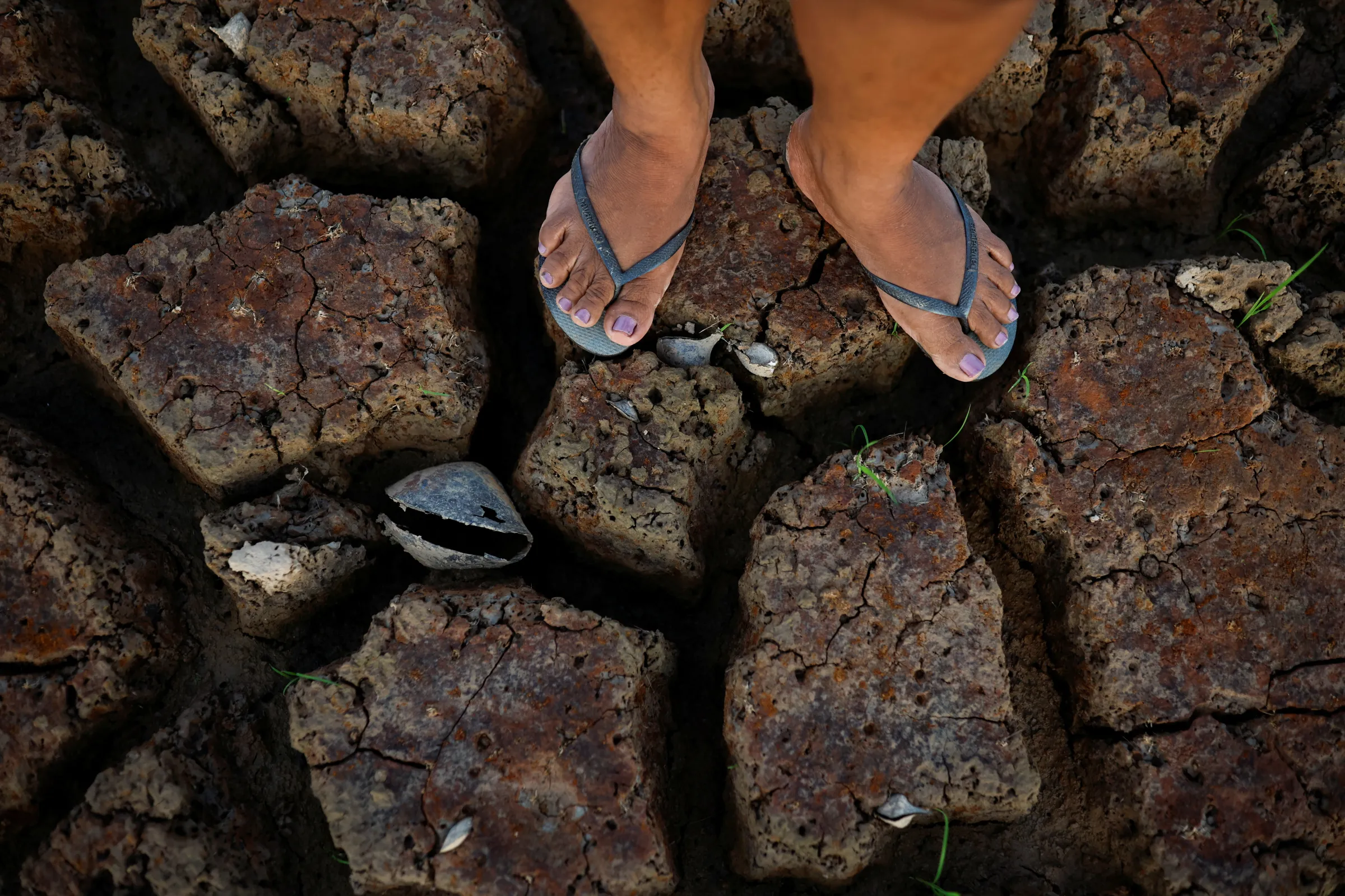Any views expressed in this opinion piece are those of the author and not of Context or the Thomson Reuters Foundation.
Mary Robinson: Earth’s life support is failing. Will we act?

A woman stands on the dry bed of a Tapajos river during the intense drought that hits the Amazon, at Prainha 1 community in Tapajos National Forest, Para state, Brazil October 10, 2024. REUTERS/Amanda Perobelli
The Planetary Health Check is a warning but if we treat science as a compass and act together, we can reverse planetary decline.
Mary Robinson is the first woman President of Ireland and former UN High Commissioner for Human Rights; former Chair of The Elders; a passionate advocate for gender equality, women’s participation in peace-building, human dignity and climate justice.
Our planet is on life support. Seven of the nine planetary boundaries that determine whether Earth will remain habitable are in the danger zone
The latest boundary to be crossed - ocean acidification - signals that the very systems we rely on for food, water, climate stability, and economic security are at significant risk.
This is not a distant possibility; it is a present-tense emergency.
As world leaders gather at the United Nations in New York this week, the question is not whether change is coming, but whether they will guide humanity into the future with courage or allow disaster to take hold.
For billions of years the ocean has been Earth’s great stabilizer, producing oxygen, regulating weather patterns, and sustaining an extraordinary diversity of life. We are now eroding that stabilizer at speed.
Since the industrial era began, oceans have become 30 to 40% more acidic because of human activity. Cold-water corals, tropical reefs, and Arctic marine life are already at risk.
Tiny sea snails called pteropods — key food for fish — show shell damage. When they decline, food webs falter, fisheries suffer, and coastal livelihoods are lost. The ocean’s warning light is flashing red.
The signal is echoed across the planetary dashboard.
The 2025 Planetary Health Check shows worsening trends in climate change, biosphere integrity, land system change, freshwater use, biogeochemical flows, and novel entities such as chemical pollution.
Only two indicators — stratospheric ozone and aerosol loading — remain in the safe zone.
There is a lesson in those exceptions: when the world treats science as a compass and acts together, planetary decline can be reversed.
The Montreal Protocol helped heal the ozone layer. Aerosol pollution is falling where serious policy has been put into place. Failure is not inevitable; it is a choice.
We know what to do
Breaching seven boundaries is like failing most of Earth’s critical health checks at once.
When we destabilise the systems that make life possible, we compromise rights, especially those of the most vulnerable and of future generations.
As United Nations High Commissioner for Human Rights, I saw how often leaders have information but lack the courage to act on it. The cost of delay is always paid by those with the least power to escape it.
The Amazon, Congo, and Southeast Asia together hold 80% of the world’s remaining rainforests and two-thirds of all terrestrial biodiversity.
A report, Three Basins, One Lifeline, underscores their global importance, showing how these forests regulate weather patterns that sustain over half of global food production and store vast amounts of carbon.
Yet only 36% of the original tropical rainforest remains intact. If we lose 20 to 25% of today’s Amazon tree cover, we risk a tipping point toward savannah, unleashing gigatons of climate pollution and slashing regional rainfall.
Deforestation in the Amazon alone can reduce rainfall on the U.S. Northwest by around 20% and halve the Sierra Nevada snowpack, a lifeline for California’s farms and cities.
This is how local ecosystem loss becomes a global chain reaction. Crops fail, prices spike, migration surges, governments destabilise, conflict spreads.
More than half of global food production and up to 8% of world gross domestic product are at risk by mid-century without urgent action, with annual losses topping one trillion dollars from crop failures and shortages.
The health of forests and the health of the ocean are two facets of the same life-support system. Endanger one, and you endanger them all.
Leaders know the direction of travel humanity must take.
Phase out fossil fuels that drive both global warming and ocean acidification. Protect and restore biodiversity on land and at sea. Elevate Indigenous Peoples’ knowledge and strengthen international cooperation with practical finance at scale - instruments like green bonds, debt-for-nature swaps, and guarantees that lower the cost of capital for countries safeguarding the planet for all of us.
Ultimately, we need to reimagine our economic system to value a living nature.
We can also embed Chief Planetary Scientists in governments worldwide; independent science leaders who unite departments around evidence-based action.
With governments already showing interest, this pioneering role offers not only a safeguard for our planet’s health but also a pathway to resilience and prosperity.
Earth’s life-support systems are failing. The ocean has raised the red flag. The rainforests are sounding the alarm. History will not remember our excuses. It will remember whether, when the bough of fate fell into our hands, we grasped it with purpose—or let it slip away.
Protect the planetary boundaries that protect us, and we protect ourselves. Fail, and we choose to leave a frightening world for generations to come. The choice is still ours; for everyone’s sake, let us choose courage.
Tags
- Fossil fuels
- Climate policy
- Loss and damage
- Forests
Related
Latest on Context
- 1
- 2
- 3
- 4
- 5
- 6














